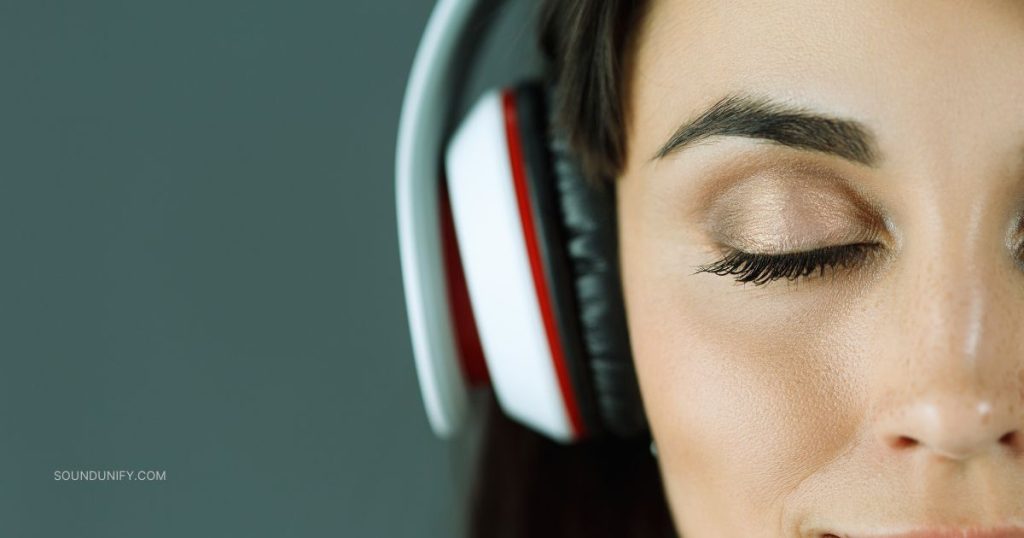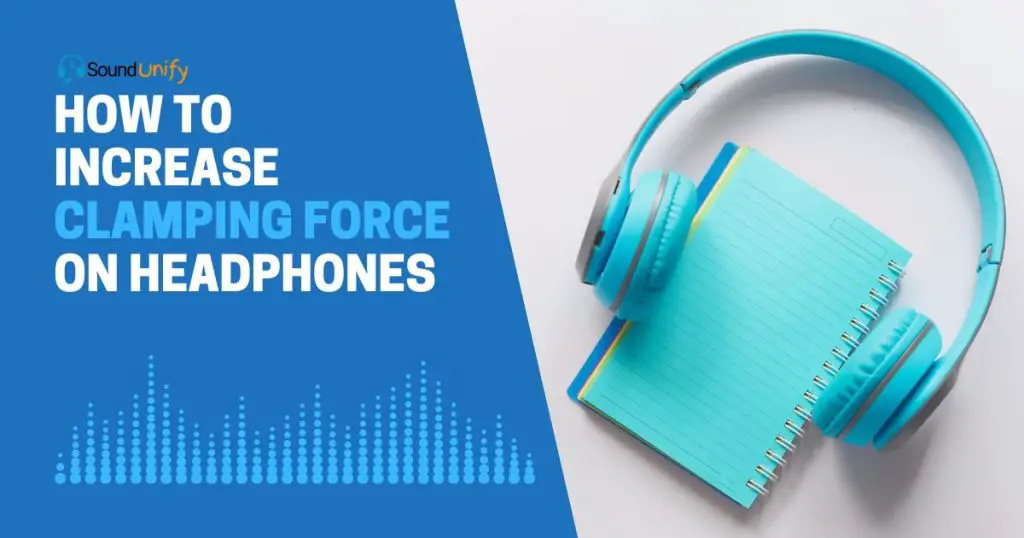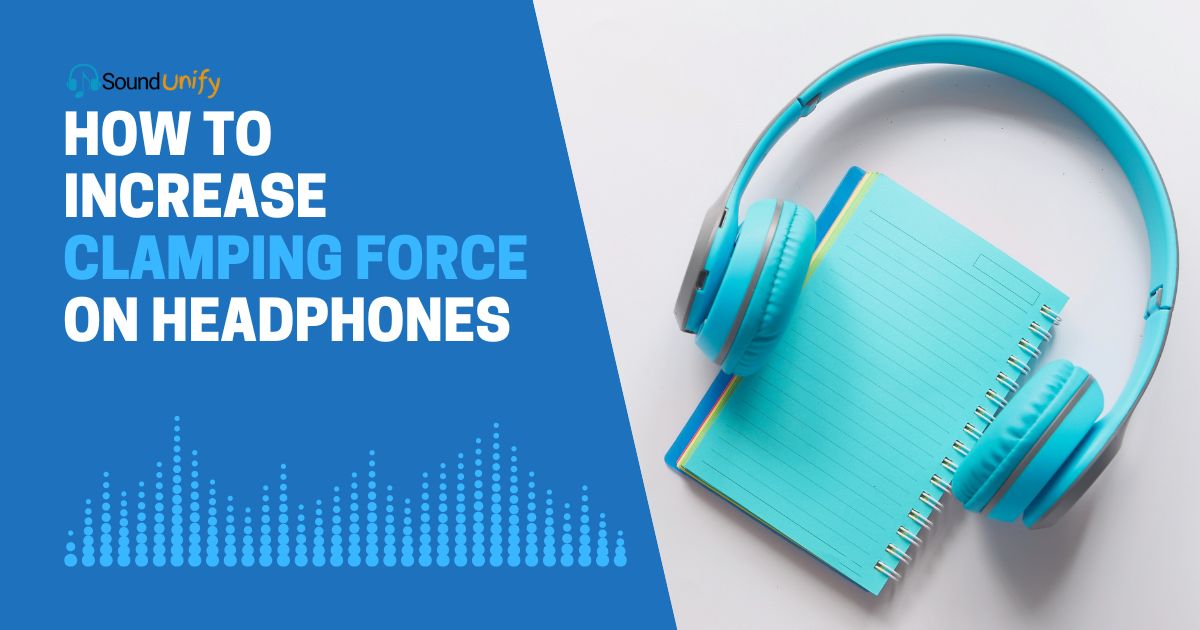Increasing the clamping force on your headphones can significantly enhance sound isolation and improve your listening experience. It's a simple tweak with profound effects.
I’m sure we’ve all been there – headphones sliding off our heads or not fitting snugly enough, leading to a less-than-ideal sound experience. It’s a common problem, but guess what? It’s also one that’s easily solvable.
This blog post will delve into how to increase clamping force on headphones. This might seem like a small detail, but trust me; it can make a difference.
So, if you’re tired of constantly adjusting your headphones, or if you’re just not getting the sound isolation you crave, stick around. I promise you; it’s going to be worth your while. Let’s dive in, shall we?
What Is Clamping Force in Headphones?

I was intrigued when I first encountered the term ‘clamping force’ about headphones. It’s not a term you’d typically come across unless you’re really into audio equipment.
But as I soon discovered, understanding clamping force can significantly enhance your listening experience.
1. Clamping Force: The Basics
So, what exactly is clamping force? Simply put, it’s the pressure your headphones exert on your head when you wear them.
But there’s more to it than that—the clamping force results from the headphones’ mechanical design and materials.
2. The Science Behind Clamping Force
From a scientific perspective, clamping force is a fascinating concept. It’s a perfect demonstration of Hooke’s Law, which states that the force a spring exerts is proportional to its extension.
In the case of headphones, the headband acts as a spring. When you put on your headphones, the headband stretches. As it tries to return to its original shape, it exerts a force on your head. This is the clamping force.
3. The Role of Materials and Design
The materials used in the headband can significantly influence the clamping force. For instance, metal headbands are typically more rigid and exert a higher clamping force than those made of plastic or other flexible materials.
The design of the headphones also plays a role. Some headphones are designed with a higher clamping force to ensure a secure fit, while others prioritize comfort and have lower clamping pressure.
4. Clamping Force and Sound Quality
Clamping force doesn’t just affect comfort; it also impacts sound quality. A good seal around your ears is crucial for sound isolation, especially with closed-back headphones.
A higher clamping force can help achieve this seal, preventing sound leakage and ensuring you get the full range of audio frequencies.
This is why studio headphones, which require excellent sound isolation, often have a higher clamping force.
5. Personal Preference: The Final Verdict
Despite all the science and design considerations, the ‘right’ clamping force ultimately comes down to personal preference. It’s a delicate balance between comfort and sound quality.
Some people, like me, prefer a tighter fit, which offers better sound isolation and a more immersive listening experience.
Others might prioritize comfort, especially for long listening sessions, and opt for headphones with a lower clamping force.
Table: The Impact of Clamping Force
| Impact | Description |
|---|---|
| Comfort | A high clamping force can cause discomfort over time, while a low clamping force might feel too loose. |
| Sound Quality | A good seal around the ears, achieved through adequate clamping force, is crucial for sound isolation and bass response. |
| Stability | A higher clamping force ensures the headphones stay in place, even when you’re moving around. |
Why is Clamping Force Important?
Clamping force in headphones is essential for a couple of crucial reasons: comfort and sound quality.
1. Comfort:
The clamping force determines how tightly the headphones press against your head. If the clamping pressure is too high, the headphones can feel too tight and cause discomfort over time.
On the other hand, if the clamping force is too low, the headphones might not stay in place, especially when you’re moving around.
Therefore, a balance must be struck to ensure the headphones are comfortable for extended periods.
2. Sound Quality:
The clamping force also plays a significant role in sound quality. A good seal around your ears is crucial for sound isolation, especially with closed-back headphones.
A higher clamping force can help achieve this seal, preventing sound leakage and ensuring you get the full range of audio frequencies.
This is particularly important if you’re in a noisy environment or using headphones for professional tasks like mixing or mastering audio.
How to Increase Clamping Force on Headphones?

I’ve spent countless hours tinkering with my headphones to get the perfect fit and sound quality. One aspect that often gets overlooked is the clamping force.
If you’ve ever felt that your headphones are too loose or don’t provide enough sound isolation, you might need to increase their clamping staff.
Here’s a detailed guide on how you can do it:
1. Adjusting the Headband
The first method to increase the clamping force is by adjusting the headband. Most headphones come with an adjustable headband that you can tighten or loosen to fit your head.
Here’s how you can do it:
- Hold your headphones with both hands, with the ear cups facing you.
- Locate the adjustment mechanism on the headband. It could be a slider or a series of notches.
- Carefully adjust the headband to make it tighter. Make sure to adjust both sides equally to maintain balance.
- Put the headphones on and check the fit. If they still feel loose, adjust the headband a bit more.
2. Bending the Headband
If adjusting the headband doesn’t provide enough clamping force, you can try bending the headband. This method requires more caution, as you don’t want to break your headphones.
Here’s how to do it:
- Hold your headphones with both hands, with the ear cups facing you.
- Gently bend the headband inward to increase the clamping force. Do this gradually and check the fit regularly to avoid over-bending.
- Once you’re satisfied with the clamping force, try the headphones on. If they’re still too loose, repeat the process.
3. Adding Padding
Adding padding to the headband is another way to increase the clamping force. This can be done by wrapping a cloth or a sponge around the headband.
Here’s how to do it:
- Find a soft material that can be used as padding. This could be a cloth, a sponge, or even foam.
- Cut the material to the size of the headband.
- Wrap the material around the headband and secure it with tape or a rubber band.
- Try the headphones on and adjust the padding as needed.
4. Using a Headphone Clamp
If the methods above don’t work, you can try using a headphone clamp. You can attach these devices to your headphones to increase the clamping force.
Here’s how to do it:
- Purchase a headphone clamp. These can be found online or at audio equipment stores.
- Attach the clamp to your headphones according to the manufacturer’s instructions.
- Adjust the clamp to increase the clamping force. Most clamps are adjustable to set the clamping force to your liking.
5. Headband Bending
In addition to the methods above, there’s another technique that some headphone users swear by.
It’s called the “Headband Bending” method. This method involves gently manipulating the headband of your headphones to increase its clamping force.
Here’s how you can do it:
- Hold your headphones by the ear cups, with the headband facing away from you.
- Gently bend the headband outward, applying even pressure. Be careful not to lean too much at once, as this could damage the headphones.
- After each bend, try the headphones on to see if the clamping force has increased. Repeat bending if it’s too loose until you achieve a comfortable fit.
6. Professional Adjustment
If all else fails, you might consider adjusting your headphones professionally. Some audio shops offer this service, and they can increase the clamping force without damaging your headphones.
Here’s how to do it:
- Find a local audio shop that offers headphone adjustment services.
- Bring your headphones to the shop and explain your issue to the technician.
- The technician will then adjust the clamping force of your headphones according to your preference.
Remember, while increasing the clamping force can improve sound quality, it shouldn’t come at the cost of comfort.
Always ensure your headphones feel comfortable on your head, even if it means sacrificing some sound quality.
7. Driver Transplant
A driver transplant involves moving the headphone drivers, which produce sound, to a different pair of headphones with a higher clamping force. This method is more complex and might affect the sound quality.
Here’s how you could potentially do it:
- Look for headphones that have a higher clamping force and are compatible with the drivers of your current headphones. The compatibility depends on the size and design of the drivers.
- Carefully remove the drivers from your current headphones. This process may require specific tools and a careful hand to avoid damaging the drivers.
- Install the drivers into the new headphones. Make sure they are securely fitted and connected correctly.
- After installing the drivers, test the sound to ensure everything works correctly.
Remember, this method requires a good understanding of headphone design and some DIY skills. It’s also important to note that this could void the warranty of your headphones.
8. Using a Heat Gun
Using a heat gun to reshape the plastic of the headphones was also suggested. This method should be cautiously approached as it could potentially damage the headphones.
Here’s an essential guide on how to do it:
- Heat the Headband: Use a heat gun to warm the headband gently. Be careful not to overheat and damage the headphones.
- Reshape the Headband: While warm, carefully bend it to increase the clamping force.
- Let it Cool: Allow the headband to cool and solidify in its new shape.
- Test the Fit: Try on the headphones to see if the clamping force has increased.
Remember, too much heat can damage the headphones, so using the heat gun cautiously is essential.
9. Wearing a Hat
Wearing a hat over the headphones was also suggested to increase pressure on the headphones, pushing them closer to the ears. This is a simple and non-invasive method to increase the clamping force. Here’s how to do it:
- Choose a Suitable Hat: The hat should be tight enough to exert pressure on the headphones but not so tight that it’s uncomfortable.
- Put on Your Headphones: Put your headphones on as you usually would.
- Wear the Hat: Put the hat on over your headphones. Adjust it until you feel an increase in clamping force.
- Adjust as Needed: If the clamping force is too high, choose a looser hat or adjust the hat’s position until you find a comfortable balance.
Remember, comfort is critical when listening to music. If any method causes discomfort, it’s best to try a different approach.
FAQs
Why is clamping force necessary in headphones?
Clamping force is significant because it affects the headphones’ comfort and sound quality.
A reasonable clamping force ensures that the headphones stay securely on your head and provide good sound isolation, which improves the overall listening experience.
Can I increase the clamping force of my headphones?
Yes, several methods exist to increase your headphones’ clamping force.
These include bending the headband (if it’s made of a flexible material), using a headphone clamp, or modifying the headphones by adding thicker ear pads.
However, these methods should be cautiously approached to avoid damaging the headphones.
Will increasing the clamping force improve the sound quality of my headphones?
A: Increasing the clamping force can improve the sound quality of your headphones, particularly in terms of sound isolation and bass response.
However, it’s important to note that too much clamping force can lead to discomfort, so it’s about finding the right balance.
Can I use a heat gun to reshape my headphones and increase the clamping force?
A: Using a heat gun to reshape the plastic of your headphones is a method suggested by some users.
However, this method should be cautiously approached as it could potentially damage the headphones.
Try less invasive procedures, like using a headphone clamp or adding thicker ear pads.
Final Thoughts
As an avid music lover, I’ve realized that the clamping force of headphones plays a crucial role in the overall listening experience. It’s like the secret ingredient that can make or break your immersion in the music.
Too loose, and you lose that intimate connection with the sound. Too tight, and it’s like having a vice grip on your head. Finding the sweet spot is a bit of a journey, involving a mix of adjustment, modification, and sometimes even a bit of DIY.
But when you hit that perfect balance, it’s pure auditory bliss. So, don’t shy away from exploring ways to increase the clamping force on your headphones. After all, we’re all in pursuit of that perfect sound experience.
James Dimento is a Chief-in-Editor of SoundUnify. He is a headphone enthusiast and creative writer passionate about audio technology. He has three years of experience writing about headphones and sound quality and is responsible for creating reviews and taking care of all administration.
